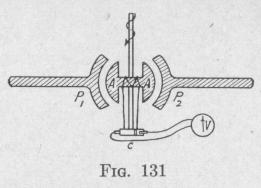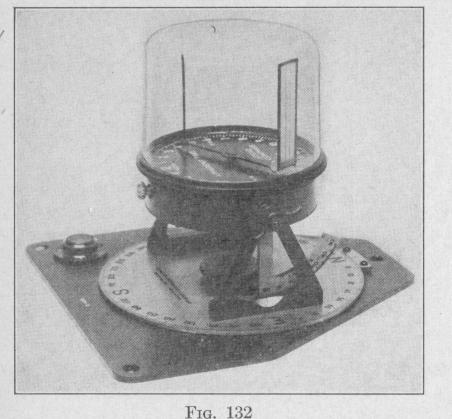170 NAVIGATIONAL COMPASSES
permeability and low coercive force, are placed on opposite sides
of the armature A, Fig. 131. The armature is rotated by a motor
about an axis fixed with respect to the airplane. The longitudinal
axis of the pole pieces passes through
the center of the armature and is
maintained horizontal however the
airplane may tilt. The axis of the
pole pieces can be turned about a
vertical axis by means of a flexible
cable connected to a graduated dial
on the instrument board.
When the axis of the pole pieces is perpendicular to the magnetic meridian, no electromotive force is induced in the armature and the indicating millivoltmeter needle is at the zero position. When the axis of the pole pieces is not in this position, the needle of the indicating instrument will be deflected. The deflection is independent of the position of the brushes on the commutator C.
With the magneto compass, a course is set and maintained exactly as with the earth inductor compass.
104. The Sun Compass. - In regions where deviations of the earth's magnetic field from the geographic meridian are unknown, and in regions where the intensity of the horizontal component of the earth's magnetic field is too weak to control the direction of a magnetic compass needle, the sun compass is available for indicating directions so long as the sun is visible. The Bumstead sun compass consists of a clock with a single hand that makes the circuit of the face once in twenty-four hours, Fig. 132. The clock is mounted so that it can be turned about horizontal pivots set in two brackets attached rigidly to a horizontal disk. The edge of the disk is marked off into degrees and cardinal points like a compass card. The disk with the attached clock can be turned in azimuth with respect to a lubber line on the base plate. The clock hand carries a shadow-pin and screen by means of which the clock can be turned till the hand points to the sun. At points in the arctic or antarctic zones, the sun remains continuously above the horizon for many days at a time. Suppose that a sun compass in the arctic zone is on the meridian of Greenwich, with the clock face parallel to the sun's rays, the clock set for Greenwich sun time and the hand pointing toward the sun, A, Fig. 133. Then the noon-midnight line of the clock face will be in the meridian plane of Greenwich. While the earth is rotating about its axis in the
THE VARIOUS TYPES 1 i
counter-clockwise direction as viewed by an observer above the north pole, it carries the instrument into the positions A, B, D, F Throughout the twenty-four hours of a complete rotation of thi
earth, the clock hand continues to point toward the sun s, as the instrument is on the meridian of Greenwich and the is set for Greenwich time.
When the instrument is on any meridian and the clock is ae for the local time of that meridian, then if the instrume
turned so that the clock hand points toward the sun, the noonmidnight line will lie in the meridian plane of the place where the instrument is situated, C and E, Fig. 133. At any particular place, the clock face must be inclined to the horizontal at an angle of (90° - latitude). To facilitate the making of this setting, there is a divided arc attached to the clock marked off to give this difference for all
latitudes at which the instrument would be employed.
In using the instrument, the clock is set for local sun time, the


